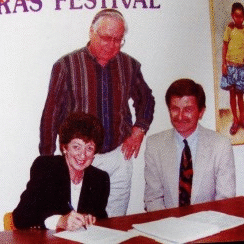INTRODUCTION OF OCAF’S HISTORY
OCAF history spans many years, OCAF remains an organization of big projects. It continues to foster visual, performing, literary, and film arts in Oceanside and its neighboring communities. All proceeds from its events and fundraisers go towards scholarships and to put out more events of artistic and cultural nature in the city.
THE FOUNDING OF OCEANSIDE CULTURAL ARTS FOUNDATION
The following is excerpted from “OMA, The Founding Years” which may be purchased at the Oceanside Museum of Art.
On February 22, 1989, Oceanside Mayor, Larry Bagley, gave his State-of-the-City address to the Oceanside Chamber of Commerce and Economic Development Council. In the address he expressed his vision for a state-of-art performing arts theatre and cultural arts center that would enrich the cultural life of the city.
Mayor Bagley felt strongly that the cultural arts complex should be independent of city government funding. He stated his desire to form a private foundation which would be the driving force behind the project and announced that he would like Oceanside residents Randy and Carol Mitchell to co-chair the project. The establishment of the founding organization would be the first step in the process and he envisioned the group as an organization comprised of a cross-section of people that represented diverse backgrounds and points of view.
The committee approved the name “Oceanside Cultural Arts Foundation” (OCAF). The designation became official at the meeting on June 7, 1989. The first elected officers included the President, Randy Mitchell; Vice Presidents Tim Aldrich, Robert Stauber, and Bob Williamson; Secretary Betty Jo Judy; and Treasurer Bob Pickrel. The Foundation also included a Board of Directors, Advisory Board Members, and Assistants to the Board.
The first official membership of a foundation began to take shape by mid- March, approximately one month after Mayor Bagley’s address at the country club. The original membership list included twenty-five couples and three individuals and was officially designated as the Cultural Arts Committee.
Of the original twenty-eight names on the committee list, twelve would ultimately have a strong impact on the eventual success in the establishment. Those people were Dr. Keith Broman, Bob Pickrel, Bob and Estelle Gleason, Jim and Betty Jo Judy, Dave Rorick, John Steiger, Dr. Robert and Charlene Williamson, and Randy and Carol Mitchell as co-chairs.
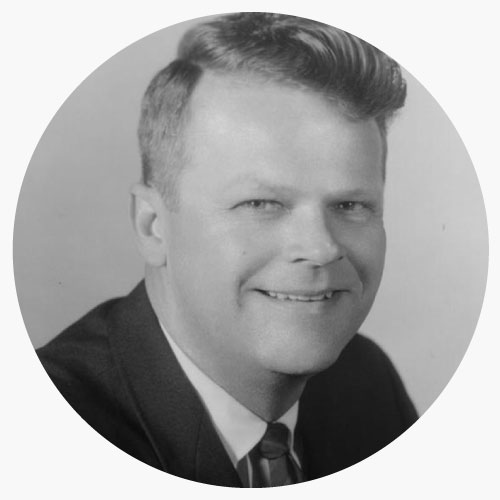
Randy Mitchell, Oceanside’s longtime resident, civic leader, and Chamber President in 1967
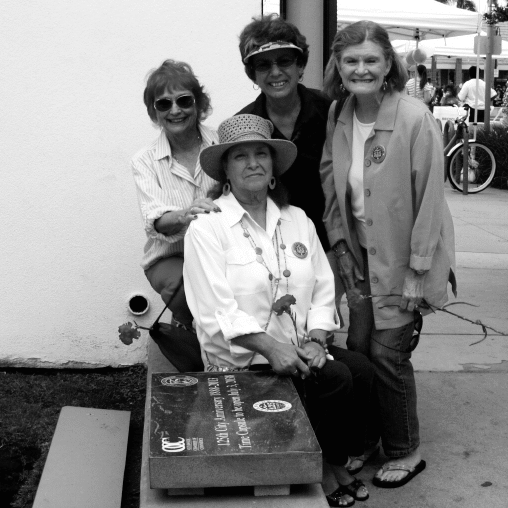
OCAF’s former Treasurer Genevieve Wunder (center) surrounded by OCAF Board Members Eliane Weidauer, Anita Romaine, and Ann Mortland, celebrate Oceanside’s 125th Anniversary. OCAF items, including programs and post cards from its events, were included in Oceanside’s 125 Anniversary Time Capsule which will be opened July 3rd, 2038.
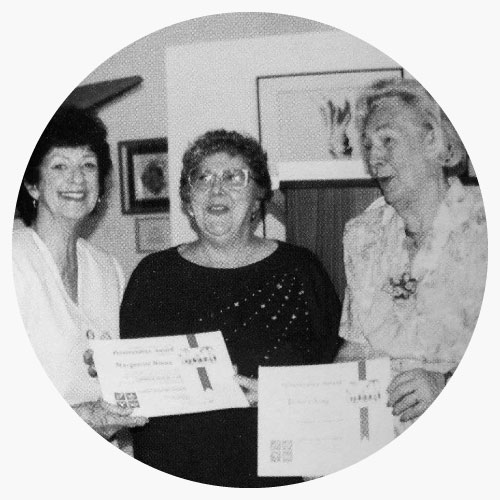
Carol Mitchell (left) presents “Perseverance Awards” from the Oceanside Cultural Arts Foundation to Marguerite Hines and Elinore King
OCAF'S Role in the Creation of
oceanside arts commission
OCAF, the ARTS COMMISSION, and DAYS of ART
In 1991 OCAF proposed the idea of an Arts Commission that would foster the arts and provide education to the community. The Arts Commission conceived of Oceanside Days of Art. Oceanside Days of Art, an annual 2-day festival, which was celebrated for 26 years. Two successful events had been held before concerns were raised over whether it was appropriate for the Arts Commission to be the proactive organizer of the event so, while Days of Art was the brainchild of the Arts Commission, it was decided that they should function as an advisory body and that the event should be placed under the direction of the Oceanside Cultural Arts Foundation. The event continued annually for an additional 24 years under the successful direction of OCAF until the curtain closed in 2018.
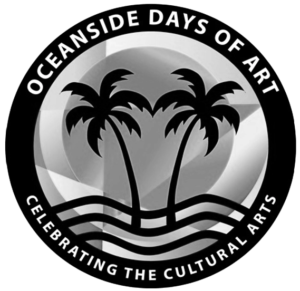
Creating the
Oceanside museum of art
In 1992 the Art Commission began searching for a venue for a museum that would be a “jewel of artistic importance.”
The Arts Commission, being an advisory body only, turned over the administration of the museum to OCAF. In September of 1993 OCAF officially chose the name “Oceanside Museum of Art” and from that point forward they pursued the goal of acquiring the Gill Building, designed by architect Irving Gill, which was situated within City Hall.
Once OCAF had officially approved the concept to establish an art museum in the Gill Building, the next step was to present the concept to the City Council.
It would take the remainder of 1993 before OCAF was ready to officially present the City Council with the concept to convert the Gill Building into an art museum. The establishment of the Oceanside Museum of Art, however, created a third and somewhat independent entity.
Now there were three working groups: the Oceanside Cultural Arts Foundation, the OCAF Organizing Committee, and the Oceanside Museum of Art. On November 30, 1993, the City held a second meeting to allow public input concerning the redevelopment study.
Members representing OCAF attended the meeting and communicated their intention to create a museum of art in the Gill Building. They also stated they hoped to raise $1.5 million and to bring their concept to the City Council in early 1994. The same day OCAF members hung a large banner across the front of the vacated Security Bank building. The banner read: Temporary Office – Oceanside Museum of Art. The North County Blade Citizen, published a photo of the banner on January 21, 1994.
To the members of the Cultural Arts Foundation, a photograph of the banner in the Blade Citizen was no small event. Nearly five full years had passed since the original Oceanside Cultural Arts Foundation first gathered in March, 1989.
In December of 1994 the Articles of Incorporation for the Oceanside Museum of Art were filed with the State of California and the Gill Building was officially established as its headquarters.
Shortly after the dissolution of the Organizing Committee for the museum and the activation of the authority of the OMA Board of Trustees over all museum business became final. And, finally, the activation of OMA’s 501(c)(3) nonprofit designation allowed donations to be received directly by the museum. The dream from nine years earlier was finally realized!
